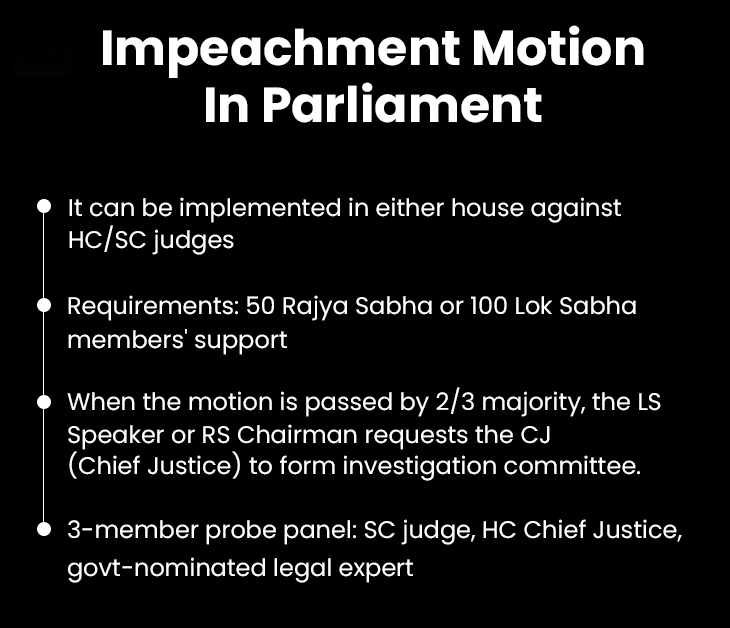Context:
The Union government will bring a motion of impeachment against Justice Yashwant Varma of the Allahabad High Court during the coming Monsoon Session of Parliament and has initiated the process of building an all-party consensus for this action.
Reason for impeachment:
- On March 14, 2025, a fire broke out at Justice Varma's official residence, revealing sacks of half-burnt currency notes. A Supreme Court-appointed inquiry panel investigated the incident.
- The panel's report, submitted on May 4, indicted Justice Varma, stating that he failed to explain the source of the cash. The panel deemed the misconduct serious enough to warrant impeachment proceedings.
Impeachment of Judges in India:
- The impeachment and removal of judges in India is a rare and complex process that involves both Houses of Parliament. Under Articles 124(4) and 124(5) of the Constitution, a judge of the Supreme Court or High Court can be removed from office by an order of the President, passed after an address by Parliament.

Grounds for Removal:
- Proved Misbehaviour: Actions such as wilful misconduct, corruption, lack of integrity, or offences involving moral turpitude constitute misbehaviour.
- Incapacity: Incapacity refers to a medical condition that includes physical or mental limitations preventing the judge from performing duties effectively.
Detailed Procedure under the Judges (Inquiry) Act, 1968:
- Motion for Removal: A motion for removal is to be signed by at least 50 members in the Rajya Sabha or 100 members in the Lok Sabha.
- Admission of Motion: The Chairman of the Rajya Sabha or the Speaker of the Lok Sabha has the discretion to admit or reject the motion after consultation.
- Three-Member Committee: If admitted, a three-member committee is constituted, comprising a Supreme Court Judge, a High Court Judge, and a distinguished jurist.
- Investigation: The committee investigates the allegations and submits a report.
- Outcome: If the judge is cleared, the motion is dropped. If found guilty, the report is tabled in both Houses of Parliament, where the motion must be passed by a special majority.
Notable Cases of Impeachment Proceedings:
- V. Ramaswami J (1993): The first judge against whom impeachment proceedings were initiated, but the motion failed to secure the required two-thirds majority in Lok Sabha.
- Soumitra Sen J (2011): The first judge to be impeached by the Rajya Sabha for misconduct, who resigned before the process could be completed.
- Resignations before Impeachment
- - P.D. Dinakaran J (2011): Resigned as Chief Justice of the Sikkim High Court amidst charges of corruption, land-grab, and abuse of judicial office, before impeachment proceedings could be initiated.
- - P.D. Dinakaran J (2011): Resigned as Chief Justice of the Sikkim High Court amidst charges of corruption, land-grab, and abuse of judicial office, before impeachment proceedings could be initiated.
Conclusion:
The impeachment process is a constitutional mechanism to ensure accountability of judges and maintain the integrity of the judiciary. However, it is a rare and complex process that requires careful consideration and adherence to the prescribed procedures.






